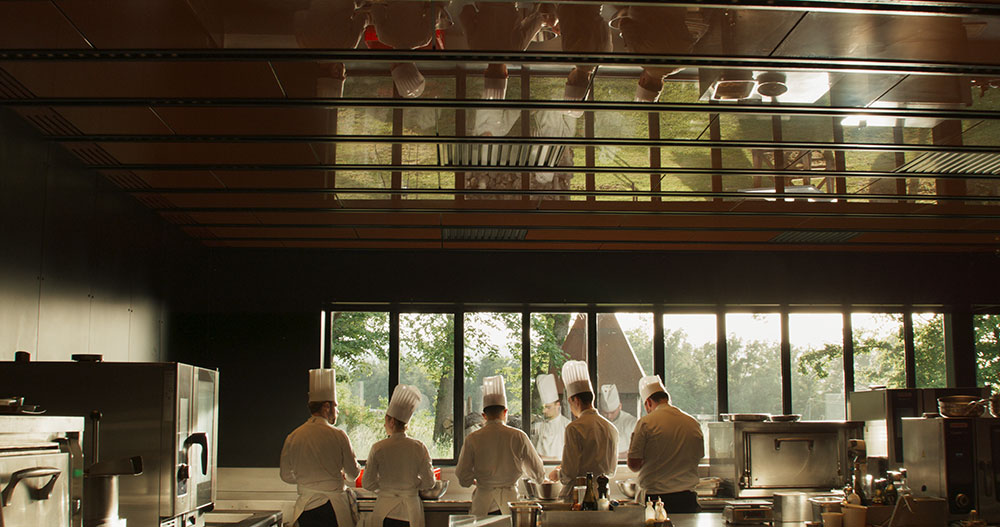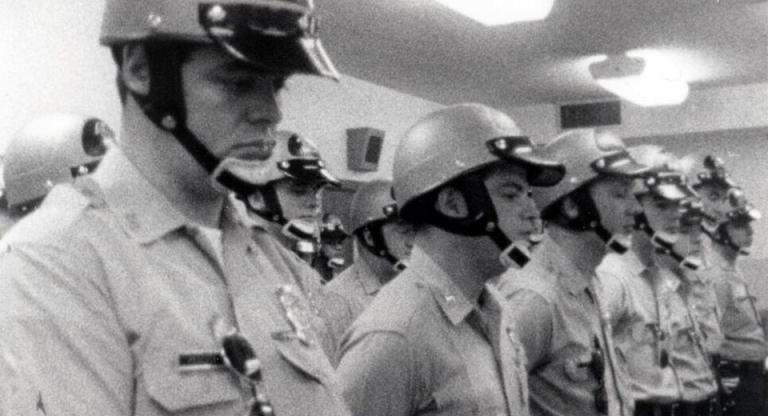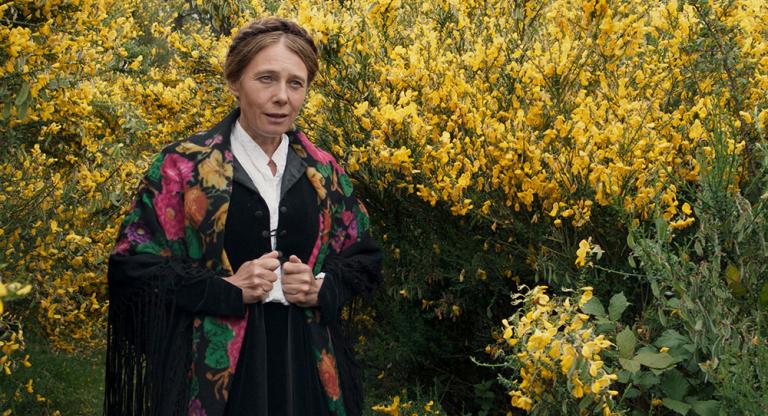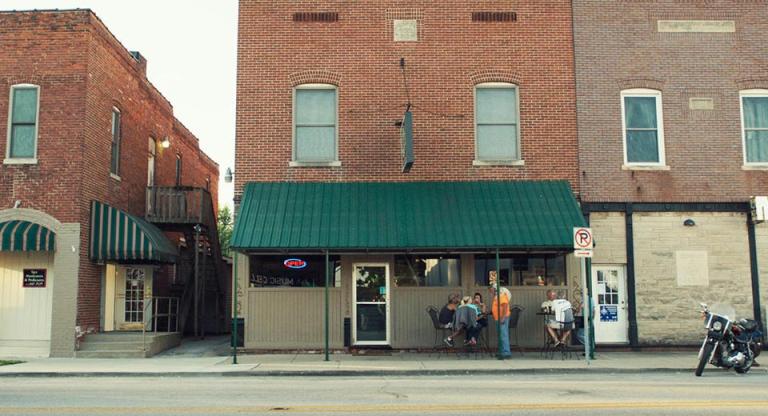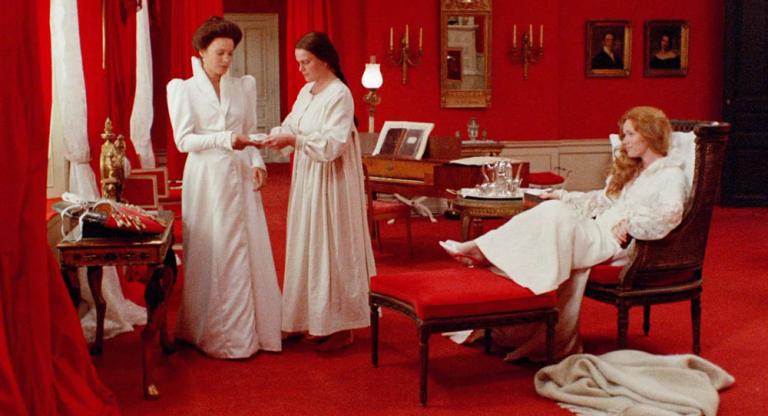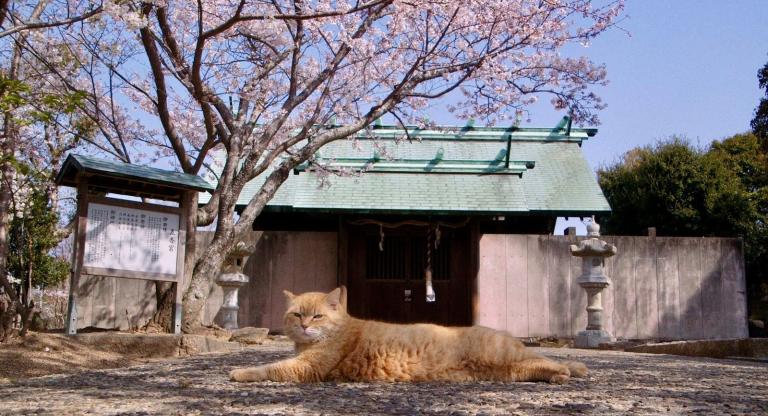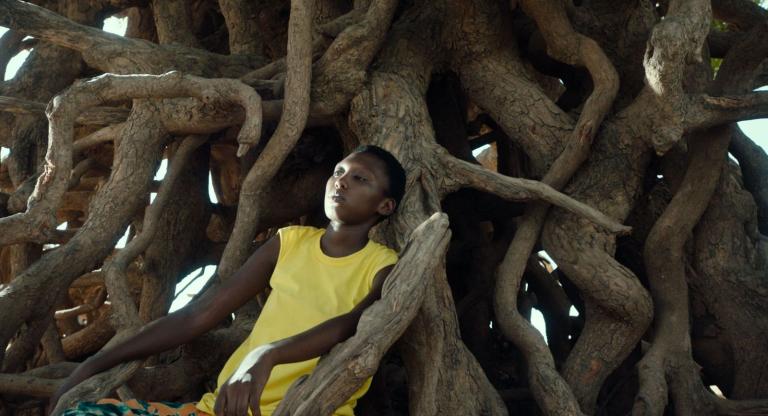When embarking on the editing phase of one of his films, Frederick Wiseman has said, he rewatches all his raw footage—often hundreds of hours—and rates each sequence according to the grading system of the Michelin Guide: three stars, two, one, or zero. Each assembly cut begins as a hodgepodge of the footage Wiseman finds most insightful or entertaining, and from this cinematic tasting menu a structure and point of view eventually emerge.
Menus-Plaisirs Les Troisgros (2023), Wiseman’s new film, features plenty of three-star footage, in multiple senses. A portrait of La Maison Troisgros, the three-Michelin-star restaurant in the Loire department of France run by chef Michel Troisgros and his sons, César and Léo, the film is a four-hour feast. Like Robert Caro, but far more prolific, the 93-year-old Wiseman seems as his career progresses to see the world in ever higher resolution—to perceive the significance of ever more granular details within an overall plan. From the farmers’ markets and foraging expeditions, where the chefs gather fresh produce, to the budgetary and aesthetic considerations of menu planning and the tweezer precision of meal prep, to the hushed ballet of lunch and dinner service and the approving wine-swirling of gastronome diners, Wiseman’s one-camera, four-person crew takes in a deeply pleasurable sampling of the effort that goes into elevating human sustenance into art (or luxury good).
Although Wiseman’s style, unchanged since the late 1960s, implies uncompromising verisimilitude—no title cards, no talking heads, no music, just fly-on-the-wall footage compiling a portrait of a complex organization of some social importance—the filmmaker has always been straightforward in stating that, through his editing, raw footage becomes compressed sequences evoking the atmosphere of a place as he recalls it, and open-ended observation takes on a critical point of view. With Menus-Plaisirs, he indulges in the pleasures of food porn familiar from many cooking competition shows and travelogue documentaries—the cheese trolley is a particular highlight—while also zooming in on a microcosm that offers multiple perspectives on sustainability and consumption, on ecology, economics, and tradition. I was honored to speak to the indefatigable Mr. Wiseman over the phone earlier this month.
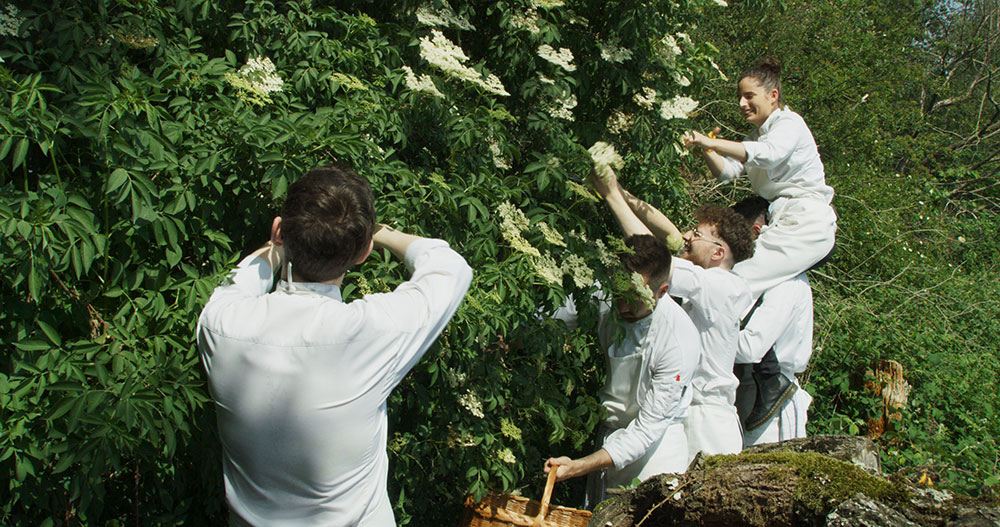
Mark Asch: James Bishop, who is assistant camera on some of your recent films, is credited as cinematographer here for the first time, stepping into a role long filled by John Davey. And you were not recording sound yourself, which you prefer to do.
Frederick Wiseman: John was supposed to shoot it, but couldn’t. Jim had been the assistant on all the films since State Legislature [2007], so he knew the signals that I used with John [when filming, to direct camera movement]. He always has one eye on me and one eye on the camera. And I have one eye on him, and one eye on what’s going on.
I was not feeling well, and I didn't really have the strength to carry equipment and the boom. So in addition to the usual signals with Jim, I carried a viewer on my neck.
MA: Do you think we can see the difference?
FW: It’s hard to answer that question — I had never shot a restaurant before.
MA: How long were your shooting days, and for what percentage of the time that you were there was the camera actually running? Is that something that changes much, film to film, for you?
FW: I think it was running a bit more here because there was always something going on. In Welfare [1975], for instance, the welfare center was open from eight in the morning until five at night. And I was there most days from eight in the morning until five at night. But the most I would shoot in the course of the day would maybe be three hours.
Here there was always something going on. We shot for seven weeks. And we were pretty much there 10 to 12 hours a day, sometimes more. We’d arrive at seven o’clock in the morning and finish at 11:30 at night. But each film presents different kinds of problems as you're filming, and [dictates] the quantity of shots. For example, a lot of [what we were] shooting in the kitchen, as you see in the film, were cutaways, or, if not cutaways, very short shots, edited together with some quite long shots. I haven’t figured out the relationship of long shots and close-ups in the final film, but I do know that I deliberately collected hundreds of tight shots, of pots, of something cooking in the frying pans. I collected them not knowing how we were going to use them, but knowing I was going to need them.
Sometimes I'd follow Michel or César, sometimes I’d follow the pastry chef. It was a bit like making a movie at La Comédie-Française, or the Paris Opera Ballet, because they were doing similar things every day. So, I'm simplifying it, but you could spend three or four hours just shooting wide shots, and then the next day shoot close ups. We watch rushes, when we’re not too tired at night, and if I didn't like the way something was shot, I could go back, because they make salmon every day, they make kidneys every day. That’s good because it gives me choices in the editing room, whereas with a film like Welfare, you only have one time to get the sequence because nothing is repeated. This is a lot like shooting La Danse [2009], or La Comédie-Française [1996], or Crazy Horse [2011].
MA: You’re talking about shooting coverage—do you record wild sound separately from when you’re recording sound simultaneously?
FW: Yes. For example, even if we weren’t shooting, when one of the waiters, came [into the kitchen] and announced the order—I collected lots of that, because I knew I would need that kind of sound in the editing. When he says, “Three salmons, four kidneys”, or whatever order they had just taken from a table. Even if we didn't film that—although we filmed that a lot—I had a lot of extra sound of that, which I used to cover the cutaways of the cooking dishes, because it gave a sense of the ambience in the kitchen.
MA: I was curious about that, because it seemed like there was a fairly elaborate sound edit for the kitchen montages.
FW: There was. I use whatever non-sync sound I have that is useful. Sometimes I use sound that was originally shot sync and I’m not using the picture, but I’m using the sound to cover a transition. Or if it’s a couple of shots of pots on the stove, and it’s dull without any sound behind it, I may take a piece of sync sound and run that underneath the pots—you know, boiling water, chicken cooking, if I wasn’t going to use that as a sync piece.
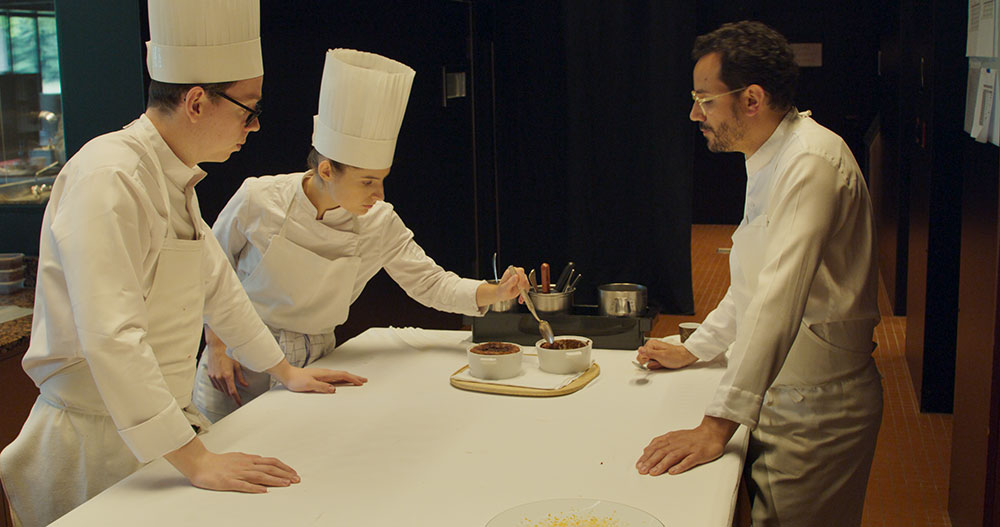
MA: Are you interacting with your subjects during breaks in the filming?
FW: That’s an extremely useful thing to do, and I’ve done that since the beginning. The people who work there know a lot more than I do about the place and the routines. I deliberately use the moments when we’re not shooting to talk with the people, as long as it doesn't interrupt their work. It’s extremely helpful to do that, because somebody will say to me, “You know, every Friday morning, at seven o'clock, the senior chefs get together.” Well, I didn’t know that. Once I’m told that I make a little note, in my notebook I carry around in my pocket. I’ve done that in all the films.
Also, people are interested in the equipment. I do what I can to demystify the process of filmmaking. If somebody wants to see how the camera works, I put the camera on their shoulder and let them look through the viewfinder. If they want to shoot a few feet you let them shoot a few feet. Similarly with a tape recorder you put the earphones [on them], you let them record some sound. The tape recorder I work with now doesn’t have a delay on it—it used to be a two second delay, and people who weren't familiar would get confused. It was a little joke, but it broke the ice. I do everything I can to demystify the processes and to be friendly, because it puts the people at ease. And it’s useful to me.
MA: Speaking of equipment and demystifying the process: Over the many decades of your career, the people that you film are more and more likely to have better and better cameras on their persons and to use them in their day-to-day life, often filming the same things you’re filming. In this film, as we see, you have some competition from the diners at the restaurant who are photographing the same food as you are, for their own purposes. I’m curious about being a nonfiction filmmaker, starting in a world where it would have been very unusual for somebody to be filming themselves in their day to day life, to making films at a moment now where that’s more or less the reality.
FW: I’ve never been concerned with that. The camera we use, with all the lenses, if one were to buy one, it would probably cost about $75,000. It’s unlikely that anybody is going to show up with a camera like that. As much as I like to fool around on my cell phone . . . The quality of still shots is quite good, but the quality when you shoot movement, it’s not in the same league.
MA: There are a number of scenes in this film that feel quite expository, whether it’s the chefs and sommeliers discussing food and wine with diners, or farmers describing their processes to the chefs. I’m curious whether it feels like these scenes were useful as exposition, or whether you felt like they were performing for each other, or . . .
FW: I don't think they’re performing. For instance, when César goes to the cattle farmer—he’d never met him before. The exposition wasn’t for me, it was for César, who knew nothing about the farm, and was interested in why it was so difficult to get biologically raised cattle for their meat. That’s why he asked all the questions about slaughtering. The big cheese factory, that was a tour that was arranged for the benefit of the apprentices working at Troisgros, the young chefs in the kitchen. Michel and César thought that they should know something about the manufacture of cheese, since it was an important part of the menu. And because many of them had the ambition, or the fantasy, that they would one day have their own restaurants. So I just happen to be lucky enough to be around when those visits took place.
MA: Sometimes your films are named after specific places, and sometimes they're named after types of places. The Store [1984], not Neiman-Marcus; National Gallery [2014], not Museum. In this film, we have a more editorial title—Menus-Plaisirs, “little pleasures.” I’m curious about titling your films, if there’s any sort of process.
FW: Well, the simpler the better. Welfare had an easy title. Hospital [1970]. The titles for most of the films appear to me to be obvious. Here, I didn’t want to call it Restaurant, which is the obvious title, or Three-Star Restaurant. It took me a while to find Menus-Plaisirs. “Menus-Plaisirs” has a bit of resonance, as far as I’m concerned, because the courtiers around Louis XIV would design treats for him, often meals, but also entertainments, and they would call them Menus-Plaisirs.
Menus-Plaisirs Les Troisgrois opens tonight, November 22, at Film Forum and December 22 at Roxie in San Francisco.
